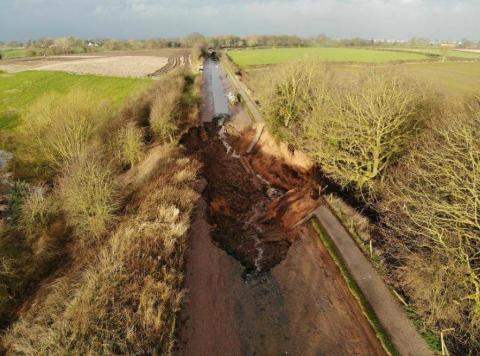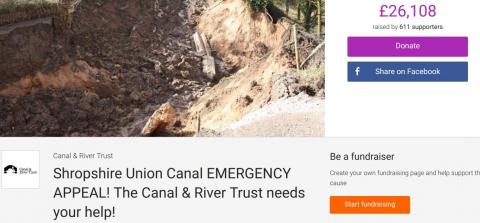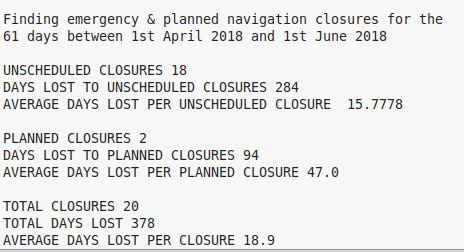C&RT refuses to produce reports on Middlewich breach
October 2018 - Boaters have long had serious doubts about the Canal & River Trust explanation of the cause of the Middlewich Breach early this year, but when one of them asked for the reports to substantiate its claim that it was caused by paddles left up on the lock above the breach site the charity – recently given an award for openness – reiterated its claims but refused to supply the documents.
The cause of of the breach of the Middlewich Branch of the Shropshire Union Canal between Wardle Lock & Stanthorne Lock, now remains unexplained. Months after the breach, the Trust claims that such information is exempt from disclosure under Regulation 12(4)(d) of Environmental Information Regulations. This regulation covers material that is still being completed, including unfinished documents and drafts.
The breach occurred in mid March with the canal not expected to open again until late December, a closure of some 280 days. The Trusts appeal on the JustGiving website, started more than six months ago, has raised just £26,108. This is somewhat less than one per cent of the £3m estimated cost of repair.
Allan Richards has been investigating Harry Random's quest to obtain a copy of C&RT's investigation into the cause of the breach.
Harry Random made his request via whatdotheyknow.com on 16th August. Unusually, he made his request under Environmental Information Regulations 2004 rather than the Freedom of Information Act 2000. He asked:
Environmental Information Regulations 2004 request:
a) Please can you supply the engineers survey & investigation reports which the C&RT have which relate to the cause of the breach which occurred on 15th March 2018 between the Wardle Lock & Stanthorne Lock, in Middlewich.
I visited the breach the following day and I feel the following is a much more likely explanation:
1) A small section of the Southern side of the Shropshire Union canal bank immediately East of the aqueduct failed and collapsed into the canal due to its poor/weak condition.
2) The collapse of the Southern side caused a blockage in the canal, and there is evidence that excess water (splash or overflow) flowed down the Northern bank just 5 or 10 metres to the East of where the main breach happened.
3) The damage to the Southern canal bank allowed water ingress which undermined the canal bed by gradually washing away material which eventually led to a catastrophic failure and breach of the Northern canal bank.
b) Generally speaking (and from the perspective of the C&RT) is there an insurance exclusion clause in place, or any financial (including the C&RT having to pay out compensation) or any funding penalty if a canal breach is found to have been caused by a lack of maintenance rather than some deliberate or accidental act?"
His request was acknowledged by Melissa Ashdown-Hoff, Information Officer – Governance, Audit & Risk who told him he was entitled to a response within 20 working days. However, he did not receive any response. Harry asked for a review of his request. C&RT failed to carry out that review. However, two weeks later they rejected his request.
Responding to part (a) of his request C&RT stated: "Our investigation into the breach confirmed that the breach was caused by all four paddles being left open at Stanthorn Lock, this caused a large surge of water which exceeded the capacity of the storm weir, resulting in the canal level rising and overtopping near the aqueduct. We have water level monitoring data which proves this.
The survey and investigation reports are currently in draft form and are exempt from disclosure under Regulation 12(4)(d) which covers material that is still being completed, unfinished documents including draft documents."
Responding to part (b) they said "The Trust does not insure the "track", i.e. the canal itself. We do insure for any third party damage caused as a result of such occurrences, e.g. flooding to a third party property due to a canal breach. There is no funding penalty under the DEFRA contract for asset failures. The funding is linked to a number of KPI's that measure condition and risk."
Whilst C&RT were strictly correct regarding no funding penalty for asset failures, they omitted to mention that the grant agreement does cover the condition of culverts and embankments with regard to flood management.
To sum up the response -
- C&RT failed to respond within 20 working days as required by law.
- C&RT failed to carry out the review Harry requested.
- Whilst claiming 'We have water level monitoring data which proves this', the Trust failed to provide that data.
- Whilst making claims about the investigation, they failed to provide any report that would substantiate those claims.
- Worst of all they failed to apply the public interest test required for Regulation 12(4)(d).
That last one needs some explanation. Environmental Information Regulations have exceptions which allow an authority to refuse to provide requested information. Under the Regulations, most exceptions are subject to the public interest test. This is an extra stage in the process of deciding what information to provide. The test requires C&RT to balance the public interest arguments for disclosing the information against those for upholding the exception.
The Information Commissioners guidance reads: 'When an exception is engaged, you must consider where the public interest lies before deciding whether to disclose the information. You can refuse to provide information only when the public interest in maintaining the exception outweighs the public interest in disclosure. When considering the public interest test, you should bear in mind the presumption in favour of disclosure under the Regulations – that you should release information unless there is a good reason not to.'
On 2nd October, Harry informed the Trust that he could not accept that survey and investigation reports were still in draft form more than six months after the breach occurred. He told them that unless they provided the information requested by the end of the week that he would make a complaint to the information commissioner so that C&RT's conduct could be investigated. It is understood that a complaint has now been made but it will be many months before an investigation is started.
Harry Random was subsequently informed that another party was requesting survey reports produced as part of C&RT's asset inspection procedures. These reports will identify any problems known prior to the breech. However, some three weeks later C&RT has still not provided this information.
Harry's request suggests he might be concerned that C&RT are wrongly blaming an unknown third party for the breech to avoid insurance claims or due to its funding agreement with Defra. However, a third possibility exits. In C&RT's canal closure figures don't hold water and Does C&RT board know the real number of emergency closures?, The Floater documented how C&RT had, over several years, changed a Key Performance Indicator (KPI) from 'number of days of unplanned closures to navigation' to 'number of days of unplanned closures to navigation within our control (individual instances over 48 hours)'. This has allowed to Trust to claim that closure days are falling year on year when the opposite is true.
Defining the Middlewich as not 'within our control' has allowed the Trust to claim under 500 lost days in 2017/18. Perhaps more importantly, it would have allowed them to exclude 265 days from C&RT's new target of less 450 lost days in 2018/19.
Below is an extract from C&RT's 2018/19 KPI's. It shows last years achievement (490 days lost), this years target (less than 450 days lost) and the number of days lost (123) in the first two months, April and May, of this financial year. The 123 figure is highlighted yellow as is the figure 2 in the ellipse indicating that in both April and May the Trust considered that its KPI target for the year might not be met. This despite a note further down the page which states explicitly that the 61 days lost in April and May due to the Middlewich breach are not included in the 123 days.
Allan Richards program has been run against C&RT's stoppages database for April and May producing the results below. Actual days lost to unscheduled closures is 284 with a further 94 days lost to planned closures. Compare that with C&RT's figure of 123 days lost!
To sum up, C&RT had already decided before Harry Random's request to exclude lost days due to the Middlewich breach from its 2017/18 and 2018/19 figures to make them look better. As such they were committed to maintaining that the cause of the breach was not 'within our control' even if an internal report stated otherwise.
Like its Middlewich Branch, the Trust's explanation for refusing to provide its investigation report does not hold water ...
Photos: (1st) The breach site, (2nd) Middlewich appeal raised less than one per cent of the cost, (3rd) An extract from C&RT's 2018/19 KPI's, (4th) Actual days lost to unscheduled closures is 284 with a further 94 days lost to planned closures. Compare that with C&RT's figure of 123 days lost!








